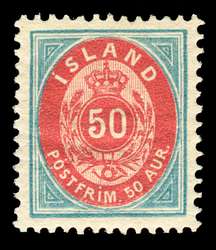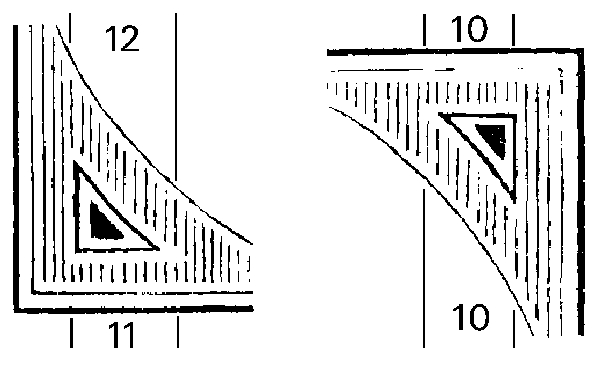|

 |
|
|
Illustration of Characteristics of the NORMAL Frame. |
|
| |
The difference is defined by the number of vertical lines, above and below the lower left and upper right corner triangles, that are interrupted by the triangle.
Normal Frame:
Lower Left Corner: 12 lines above, 11 lines below are interrupted.
Upper Right Corner: 10 lines above, 10 lines below are interrupted.
Inverted Frame:
Lower Left Corner: 10 lines above, 10 lines below are interrupted.
Upper Right Corner: 11 lines above, 12 lines below are interrupted. |
|
|
|
| Iceland: 1892-1900 Bicolored Numerals -- Normal and Inverted Frames |
|
by Jay Smith
[This article presents information and an illustration from the AFA Iceland Specialized Catalog 1997 of which I was the translator (from the 1995 edition) and principal editor of the 1997 English edition. A 2016 edition (in Danish) was the next to include Iceland and this information. The 1997 English translation and the 2016 catalog are still in-print and available, here.]
How the stamps were printed: In the book One Hundred Years of Icelandic Stamps, author Jon Adalsteinn Jonsson explains that for reasons of economy and expected low print volume, the early Icelandic stamps were printed using only a single block (plate) of 25 clichés and that each sheet thus had to be printed four times to receive all 100 stamp impressions. This plate-making method was used for all the aur denomination stamps (both regular postage and official) until the 50 and 100 aur bicolored stamps were issued in 1892, when plates of 100 clichés were made. From that point on, Jonsson says, the newly created denominations, including the 4 and 25 aur stamps in 1900, were made with plates of 100 clichés. The use of the previous 25-subject plates continued for the previously created denominations.
The bicolored stamps: Only four of the 1892-onward new denominations were bicolored: 4, 25, 50, and 100 aur. With separate clichés, and plates, for the frame vs center of each stamp, the opportunity existed for the frames to accidentally inverted relative to the centers. (No inverted centers, relative to the whole sheet, are known for these issues.)
Of these four regularly issued denominations, the 4 aur and 25 aur exist only with perforation 12.75; The 100 aur only with perforation 14 x 13.5; and the 50 aur in both perforations. The 25 aur, according to Regeling in Stamps of Iceland 1872-1904, has only one regular printing and delivery to the postal authorities, however, specialists are aware of two distinct color shades that many consider to be a collectible difference. All of the foregoing were overprinted "I GILDI / '02-'03" (translation: valid) in black (4 aur, both 50 aur perforations, and 100 aur; 25 aur also exists but is a great rarity) or red (25 aur, both colors). Additionally, the "I GILDI" overprints exist in four basic overprint types and with various printing errors (inverted, missing characters, etc.). Lastly, the four regularly issued stamps and the four denominations with "I GILDI" overprint, were reprinted with perforation 12.75 and the larger crown watermark (came into use in 1902) as specimen stamps to be sent to the Universal Postal Union for distribution to its members. All of these variations exist with the normal and inverted frames.
The frames: The same plate (arrangement of clichés) was used for all the bicolored stamps. 51 of the frames are normal / upright and 49 are inverted. It is not known if the engraver of the mother die for the frames intended that the details of the frame design not be identical at top vs bottom. Clearly the printer was not aware of the difference. The philatelic distinction of "normal" vs "inverted" seems to simply be based on defining the majority quantity as the "normal".
The characteristics: The defining characteristics of the normal vs inverted frame, as illustrated above, are the number of vertical lines, above and below the lower left and upper right corner triangles, that are interrupted by the triangles. Because the rotation of the frame changes the concepts of "above" and "below" the triangles, when the number of lines is not equal, be sure to pay attention to the differences noted. [Perhaps it would be less confusing to speak in terms of outboard and inboard (of the triangles), which do not change even if rotated, thus the referenced numbers of lines would not change.]
Normal Frame:
Lower Left Corner: 12 lines above, 11 lines below the triangle are interrupted.
Upper Right Corner: 10 lines above, 10 lines below the triangle are interrupted.
Inverted Frame:
Lower Left Corner: 10 lines above, 10 lines below the triangle are interrupted.
Upper Right Corner: 11 lines above, 12 lines below the triangle are interrupted.
I have not found any "tricks" for quicker identification of the two types. I use a 10x magnifying glass and count using the tip of a pair of tongs to keep track of what line I am counting. It is only necessary to count in either the lower left or upper right corner and either below or above the triangle (though a postmark may decide for you which corner to use). A single count in one location is enough information to identify the stamp as a normal or inverted frame.
For some reason, presumably that the equal quantities mean that there is no market value difference between normal and inverted frames, stamp dealers have not listed the two types in their price lists. (I don't yet list them separately, but I plan to start doing so soon.) Of the catalogs, only the AFA Iceland Specialized Catalog 1997 lists the two types.
Icelandic Varieties are offered for sale on the SPECIALIZED STAMPS pages. Most of the offered items don't mention if they are normal or inverted frame (that will change over time); you are welcome to ask which an item is. Iceland 1876-1895 Perforation 14 Numerals and Iceland 1896-1901 Perforation 13 Numerals and Iceland 1902 I GILDI Overprints.
High quality and unusual Icelandic stamps (not necessarily varieties) are offered for sale on the GALLERY pages. Most of the offered items don't mention if they are normal or inverted frame (that will change over time); you are welcome to ask which an item is. Iceland 1876-1895 Perforation 14 Numerals and Iceland 1896-1901 Perforation 13 Numerals and Iceland 1902 I GILDI Overprints.
Any of the applicable stamps listed in the NORMAL STAMP LISTINGS can be requested with normal and/or inverted frame. Iceland 1876-1895 Perforation 14 Numerals and Iceland 1896-1901 Perforation 13 Numerals and Iceland 1902 I GILDI Overprints.
|

